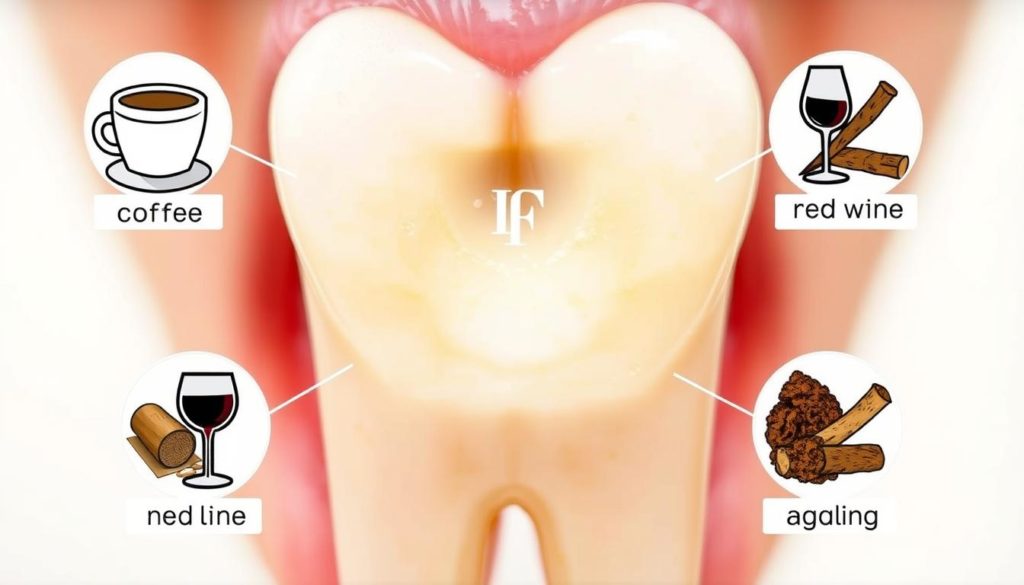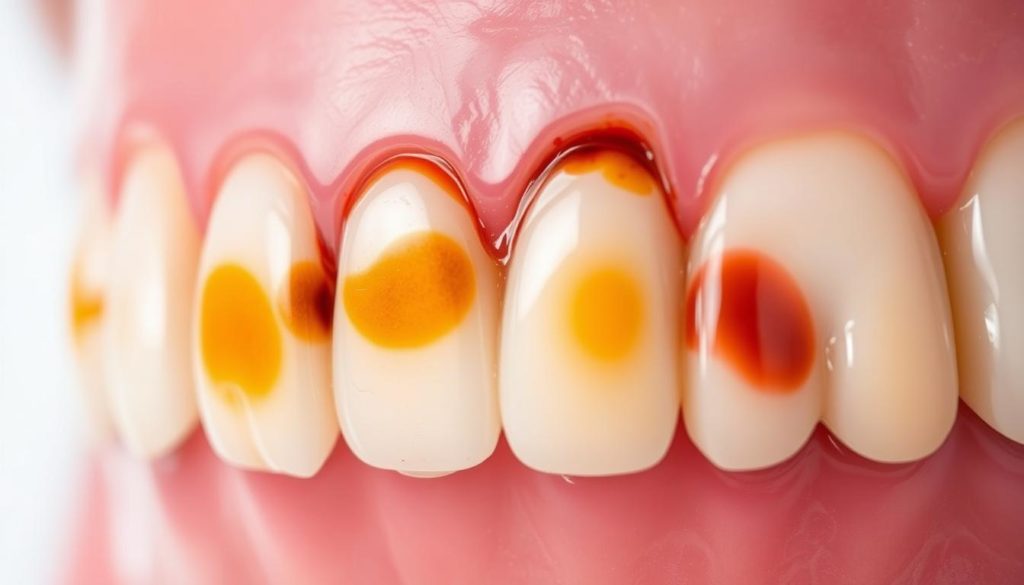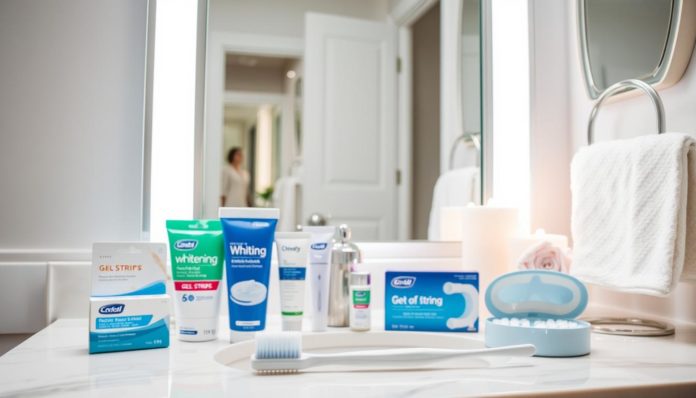Did you know that over 45 million Americans have tried teeth whitening products? This is a big number!
Having discolored teeth can make you feel less confident. It’s important to tackle this problem directly. No matter what caused your stained teeth, there are many ways to make them whiter.
You can whiten your teeth at home using strips, trays, or toothpaste. These are easy to use by yourself.
For better results, you might consider going to a dentist like those at Real Life Dental. Professional treatments often give a more noticeable change. They use strong ingredients to clear away both surface and deep stains. This helps you get the bright smile you desire.
Understanding the Causes of Tooth Discoloration
To keep your smile bright, knowing the causes of tooth discoloration is key. Daily habits and health issues can make enamel discolored. This often leads to the need for dental discoloration treatment.

Dietary Habits
Our diet plays a big role in dental health. Drinks like coffee, tea, and red wine can stain teeth. They have strong pigments that stick to enamel, causing noticeable stains over time.
Tobacco Use
Nicotine and tar from smoking can also discolor teeth. These substances settle into the enamel and create hard-to-remove stains. Regular brushing often can’t get rid of them.
Medications and Medical Conditions
Some medications and illnesses can also cause teeth to change color. Antibiotics, antihistamines, and blood pressure medications can lead to discolored enamel. Conditions that affect enamel or trauma to teeth also contribute to discoloration. As we get older, our enamel thins, showing more of the yellow dentin beneath.
Types of Tooth Discoloration
Tooth discoloration comes in three main types: extrinsic, intrinsic, and age-related. Each one has its own causes and affects teeth differently. Knowing these types can help you choose the right treatment for stained teeth.
Extrinsic Discoloration
Extrinsic discoloration affects the tooth’s outer layer, or enamel. It’s usually caused by things like coffee, tea, and red wine. Smoking can also stain teeth. Brushing often and getting professional cleanings can combat this discoloration.

Intrinsic Discoloration
Intrinsic discoloration hits the tooth’s inner structure, known as dentin. It can happen for many reasons, such as too much fluoride in childhood or certain meds. Trauma to teeth is another cause. Fixing this may need more invasive treatments like veneers or bonding.
Age-Related Discoloration
Age-related discoloration is a mix of extrinsic and intrinsic factors. As we get older, our enamel thins, showing more of the yellow dentin. Also, years of eating or drinking staining foods can darken teeth. Regularly seeing the dentist and considering whitening treatments can help with this type of discoloration.
Top At-Home Teeth Whitening Treatments
Looking for a simple way to make your smile sparkle? At-home teeth whitening treatments are both effective and easy to get. Let’s dive into the best methods that can brighten your smile.
Whitening Strips
Whitening strips are a go-to for making teeth white. They’re coated with a special gel to bleach teeth. They fit the shape of your teeth perfectly, making sure every part is covered. It’s an easy way to get a brighter smile without much effort.
Whitening Trays
Whitening trays use bleach to whiten your teeth. You can get them over-the-counter or from your dentist for a perfect fit. Fill the trays with the solution and wear them as directed. With regular use, they provide an all-around whiter smile.
Whitening Toothpaste
Whitening toothpaste gently scrubs away stains. It may not work as fast as strips or trays, but it’s great for daily use. Regular use can slowly make your teeth shine brighter.
| Method | Usage | Benefits |
|---|---|---|
| Whitening Strips | Adhesive strips applied to teeth | Easy to use, conforms to teeth shape |
| Whitening Trays | Trays with bleaching agent | Effective, personalized fit with custom trays |
| Whitening Toothpaste | Brush teeth regularly | Mildly abrasive, good for maintenance |
Professional Teeth Whitening Procedures
At Real Life Dental, professional teeth whitening is designed to give you big changes. It starts with a detailed look at your dental health. This helps personalize your treatment. We use a strong peroxide gel to speed up the whitening. This tackles tough stains that over-the-counter kits can’t.
The peroxide gel gets deep into the tooth enamel, targeting the root of discoloration. With the help of modern technology, like lights or lasers, it works faster. This means you see bright results quickly, making it a favorite option for many.
Real Life Dental puts your comfort and safety first while aiming for great whitening success. We tailor each treatment to fit your specific needs and sensitivities. This minimizes discomfort and boosts the positive effects.
| Aspect | Professional Teeth Whitening | At-Home Whitening Kits |
|---|---|---|
| Consultation | Yes, with dental examination | No |
| Peroxide Concentration | High | Low to Moderate |
| Technology Used | Advanced (light or laser) | Basic |
| Results | Dramatic and swift | Gradual and modest |
| Customization | Yes, tailored treatments | No |
Combating Poor Oral Hygiene
It’s key to keep up with oral hygiene to stop tooth discoloration. Brushing and flossing regularly are important. They prevent plaque buildup. This helps avoid stains from poor dental care.
Plaque and tartar buildup can make your teeth look bad. It leads to discoloration and cavities. So, it’s essential to take care of your teeth.
Regular dental checkups are also critical for a white smile. They help get rid of hard plaque that brushing can’t. This ensures your teeth stay healthy and bright. Plus, visits to the dentist give you custom tips to better your oral hygiene.
“The key to a bright smile lies in consistent dental care and professional guidance,” remarks Dr. Jessica Smith, renowned for her expertise in dental health.
Here are steps to enhance your oral hygiene:
- Brush your teeth twice daily with fluoride toothpaste.
- Floss regularly to remove debris between teeth.
- Schedule routine dental checkups for professional cleanings.
- Adopt a balanced diet low in sugary foods to prevent cavities.
Tips for Preventing Tooth Staining
Want a bright smile? It takes care and good advice for preventing tooth staining. Avoiding tobacco is key. Tobacco, whether smoked or chewed, causes teeth to yellow. It’s best to cut it out entirely.
Think about what you eat and drink too. Coffee, red wine, and berries can stain your teeth. Try to enjoy these in small amounts. Or, drink water right after to clean your mouth.
- Avoiding tobacco helps maintain white teeth and improves overall health.
- Dietary adjustments like rinsing with water after consuming staining foods can mitigate their effects.
Small changes make a big difference in preventing tooth staining. Keeping your smile bright is all about sticking to good habits. This is essential for great dental health!
Maintaining Your Whitening Results
To keep your smile bright, a good routine is key. Start by making some important habits part of your daily life.
Daily Oral Hygiene
Brush twice a day with a whitening toothpaste. Don’t forget to floss once a day to keep stains away. A mouthwash for stain prevention can also help.
Regular Dental Check-ups
It’s important to have regular dental visits. Your dentist can get rid of surface stains and check for problems. Make these visits a mainstay of your whitening upkeep.
Lifestyle Adjustments
Small changes in your daily life can make a big difference. Try drinking colored drinks with a straw to avoid stains. Washing your mouth out after eating or drinking colored things also helps.
Who is a Good Candidate for Teeth Whitening?
To see if teeth whitening is right for you, there are key things to think about. First, a dental health assessment is critical. Dentists need to check for gum disease or enamel damage before starting. It’s important for patients to have overall good oral health.
Often, people want to know if their kind of stains will lighten. Common stains from food and drinks like coffee or wine are usually easy to fix. But, deeper stains from medicine or injury might need different treatments. Talking to a dentist can give you personalized advice. Find out more about qualifications for whitening here.
Understanding what to expect is also vital. Not every stain will fade the same way with treatment. Also, old dental work like fillings and crowns won’t get whiter. Knowing what whitening can really do is essential.
Here’s a simple guide to make things clearer:
| Factor | Consideration |
|---|---|
| Oral Health | You need healthy gums and strong enamel to start. |
| Type of Stains | Stains from food are simpler to treat than those from medications or injuries. |
| Previous Dental Work | Dental fixes like fillings and crowns won’t bleach. |
Talking to a dentist, such as Dr. Julie Glud in Lombard, IL, is a good step. This meeting can help set realistic expectations. It’s key for getting the best results.
Understanding Professional Teeth Whitening vs. At-Home Treatments
When deciding between at-home or professional whitening, many factors matter. A critical difference is treatment effectiveness. Professional teeth whitening gives quick, strong results. This is because it uses high-grade bleaching agents, often activated by lights or lasers.
At-home methods, however, may fit better into your schedule and budget. They usually need more uses over time for visible changes. This means you might spend more time to get results.
Looking at cost considerations, professional treatments cost more at first than at-home options. Yet, this higher price often means professional guidance. This can help manage safety and sensitivity issues better. At-home options are less expensive but can risk misuse. This misuse may lead to sensitivity or irritation.
To make it clearer, here’s a side-by-side comparison:
| Aspect | Professional Whitening | At-Home Whitening |
|---|---|---|
| Treatment Effectiveness | High, fast results | Moderate, slower results |
| Cost Considerations | Higher upfront cost | Lower but may need more products |
| Safety and Sensitivity Issues | Handled by dentists | Possible misuse, higher sensitivity |
Choosing between at-home and professional whitening hinges on what you value in effectiveness, cost, and safety. Both options have their strengths and weaknesses. The best choice depends on what suits your needs and situation best.
Navigating Tooth Discoloration Solutions
Understanding tooth discoloration means knowing why it happens and choosing the right fixes. What you eat and your age are big factors. Certain foods and drinks can stain your teeth. Also, as you get older, your enamel changes color. Knowing how diet and aging affect your teeth can help you keep them healthy.
Choosing the right whitening products can be tricky with so many options available. Your choice should fit your needs, taking into account the type of stains and your dental health. Products like whitening strips and toothpaste are easy to use at home. But, professional treatments often offer stronger results. It’s important to find what works best for you.
Getting advice from dentists like Dr. Twohig at Weyauwega is key for great results. They can create a plan that targets your tooth discoloration while also looking after your overall dental health. This way, the treatment you get is not only safe and effective but also right for you. It leads to a brighter and healthier smile.
FAQ
What are the common causes of tooth discoloration?
Tooth discoloration comes from different sources like diet (drinking coffee, tea, red wine), smoking, some medicines, and getting older. This aging makes the enamel thinner.
How do professional teeth whitening procedures work?
Dentists at places like Real Life Dental use strong peroxide gel in professional whitening. They may also use lights or lasers to speed up the process. This gives fast, noticeable results.
What types of tooth discoloration exist?
There are three kinds of tooth discoloration: extrinsic (on the enamel), intrinsic (inside the tooth), and age-related (a mix of both). Enamel gets thinner with age.
Can poor oral hygiene lead to tooth discoloration?
Yes, not taking care of your teeth can lead to plaque and tartar. This causes stains. Brushing, flossing, and dental cleanings can stop these stains.
Are at-home teeth whitening treatments effective?
Whitening strips, trays, and toothpastes work on surface stains at home. But they take longer and need more applications than professional treatments.
How can I prevent tooth staining?
Stop stains by keeping your mouth clean, avoiding foods with lots of color, and not smoking. Seeing your dentist often helps too.
What kinds of at-home teeth whitening treatments are available?
For home use, there are whitening strips, trays, and toothpastes. They use gentle abrasives and bleach to tackle surface stains.
How can I maintain my whitening results?
Keep your teeth white by cleaning them well, using whitening toothpaste and mouthwash, and changing your habits. For example, drink colored drinks with a straw. Don’t forget regular dentist visits.
Who is a good candidate for teeth whitening?
If you have healthy teeth and gums, you’re likely a good fit for whitening. Teeth with surface stains from food or drink respond well. It’s a good idea to talk to a dentist first.
How do professional teeth whitening treatments compare to at-home treatments?
Professional whitening is quicker and stronger than home kits. It uses powerful bleach and sometimes lights or lasers. Home kits are cheaper and easier but slower. A dentist makes the professional treatment safe.
What remedies are available for tooth discoloration?
You can fight discoloration by eating right, using whitening products, getting professional treatments, and keeping your mouth clean. Talk to a dentist for advice tailored to you.


